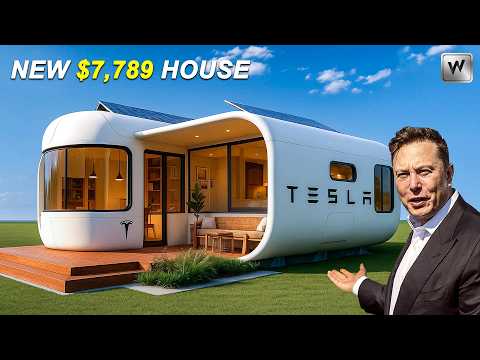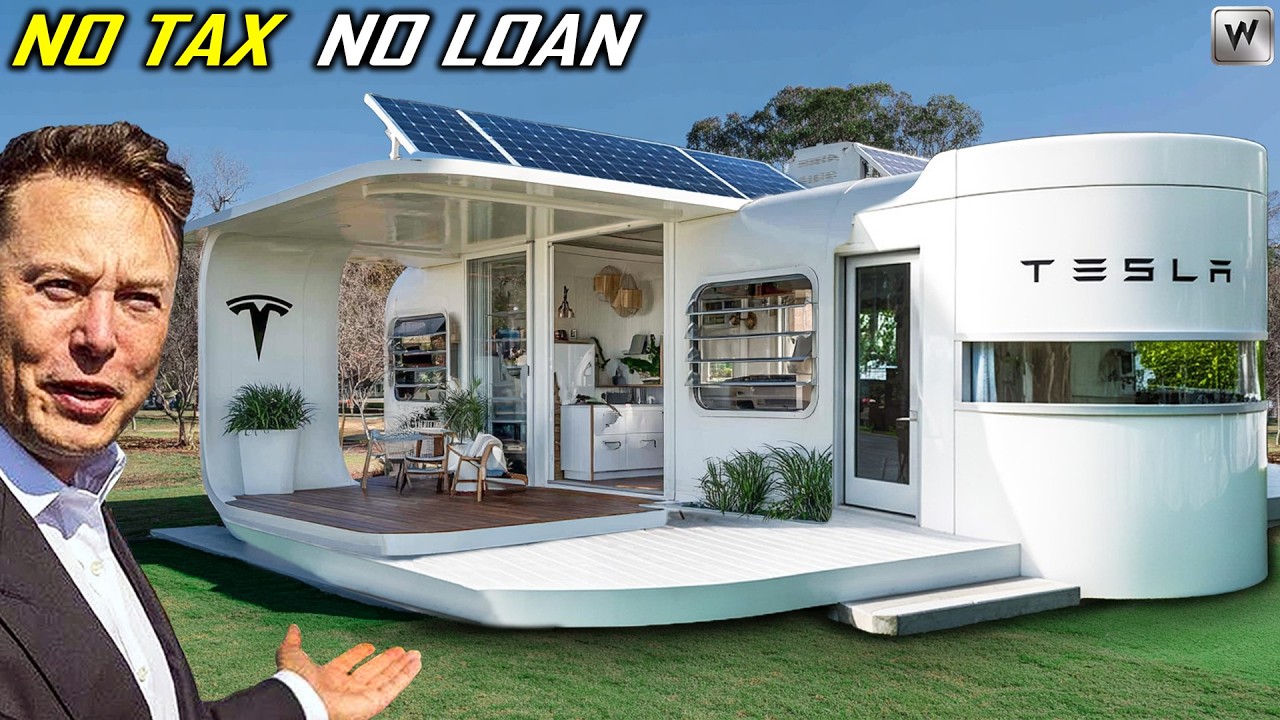
Elon Musk has announced plans for a revolutionary Tesla Home set to launch in 2026, priced at just $7,759. Exciting rumors suggest that land could be included for free, promising affordable living and a new way to build communities worldwide. Could this be the future of sustainable, cost-effective housing?
When Elon Musk speaks, the world listens. And this time, he’s not talking about rockets to Mars or self-driving cars. Instead, Musk has set his sights on something closer to home — literally. The billionaire innovator has unveiled the Tesla Home, a futuristic and affordable housing concept priced at just $7,759, sending shockwaves through the global housing market. But that’s not all: swirling rumors claim that in certain projects, land might be offered for free, creating a vision of communities where sustainable living is both accessible and revolutionary.

The Housing Crisis Meets Musk’s Vision
Across the globe, millions of families struggle with skyrocketing real estate prices, unaffordable rent, and housing shortages. Cities from Los Angeles to London are facing what experts call a “housing affordability crisis.” Enter Elon Musk — a man known for tackling impossible challenges. If his Tesla Home becomes a reality by 2026, it could reshape not just neighborhoods, but entire economies.
The core idea is simple yet groundbreaking: build homes that are energy-efficient, modular, transportable, and ridiculously affordable. At under $8,000, Tesla Homes cost less than a used car, yet promise features that rival or even surpass traditional housing.
What Is the Tesla Home?
Although Tesla has not released the full specifications, insiders and early concept leaks suggest that the Tesla Home is:
- Compact and Modular: Around 350 square feet, expandable through modular add-ons.
- Self-Sustaining: Equipped with Tesla Solar Roof panels and Powerwall batteries, allowing complete off-grid living.
- Smart-Integrated: Fully connected with Tesla AI systems, capable of syncing with Tesla vehicles, Starlink internet, and home automation.
- Portable: Designed to be transported easily, making it possible to “move your house” without buying a new one.
- Ultra-Durable: Built with advanced sustainable materials engineered for decades of wear.
At its core, the Tesla Home is not just a house. It’s a lifestyle package, combining affordability, sustainability, and futuristic design.
Rumors of “Free Land”
Perhaps the boldest — and most controversial — aspect of the announcement is the rumor that land may be included for free in certain Tesla Home projects. While details remain unconfirmed, sources close to Tesla hint at collaborations with governments and private landowners. The idea? Offer unused or government-owned land at no cost to Tesla Home buyers, creating affordable communities from the ground up.
Imagine thousands of families receiving both a low-cost Tesla Home and a plot of land to live on — a concept that could dismantle the age-old barrier between people and property ownership.
The Social Media Frenzy
As soon as Musk teased the project on X (formerly Twitter), hashtags like #TeslaHome and #FreeLandHousing trended worldwide. Fans hailed Musk as a “modern-day hero” tackling one of humanity’s most urgent crises, while skeptics warned of potential overhype. Memes of tiny futuristic homes flooded Instagram, and TikTok influencers speculated whether the $7,759 price tag was even possible in today’s market.
One viral post read: “Elon Musk doesn’t want to sell you just a car anymore — he wants to sell you your future house… for the price of a used iPhone collection.”
How Could It Work?
Experts say the Tesla Home could rely on scaling production and cutting-edge materials. Just as Tesla drove down electric car costs by innovating battery technology, the company could apply similar methods to housing:
- 3D-Printed Structures: Tesla might partner with advanced 3D printing companies to produce walls and modules quickly and cheaply.
- Gigafactory Homes?: Some speculate Tesla’s factories could double as housing production centers, churning out thousands of units per month.
- Minimalist Design: By focusing on essentials and cutting luxury costs, Tesla could reduce prices without compromising quality.
The free land component, however, is harder to explain. Analysts suggest Musk could negotiate with rural governments struggling with declining populations. By offering Tesla Homes plus free land, regions could attract new residents, stimulate local economies, and experiment with Musk’s “community of the future.”
Critics Speak Out
Of course, not everyone is convinced. Housing experts point out several challenges:
- Land Ownership Laws: Offering free land is complicated, especially in countries with strict regulations.
- Infrastructure Costs: Even if the house is cheap, building roads, plumbing, and schools for new communities costs billions.
- Scalability: Producing millions of Tesla Homes worldwide might prove more difficult than producing cars.
- Speculation Risks: Some warn that “free land” could spark speculation, with investors snapping up Tesla Homes only to flip them for profit.
“Affordable housing is not just about the cost of the house,” said urban economist Lisa Harding. “It’s about the entire ecosystem around it. Musk’s vision is bold, but reality may prove far more complicated.”
Supporters Call It a Revolution
Despite the skepticism, supporters believe the Tesla Home is exactly the kind of bold experiment the world needs. Imagine climate refugees, homeless families, and struggling young workers all gaining access to dignified, affordable housing.
“Elon Musk wants to take us to Mars,” one fan tweeted, “but before that, he might just fix housing on Earth.”
Tesla Homes and the Future of Communities
If successful, Tesla Homes could give rise to “Tesla Towns” — self-sustaining communities powered entirely by renewable energy. With Tesla cars in the driveway, Starlink satellites providing internet, and Tesla Homes as the centerpiece, Musk could create a vertically integrated ecosystem unlike anything seen before.
Picture driving your Tesla Model 3 back to your Tesla Home, plugging it into your Tesla Powerwall, and streaming movies via Starlink — all without a utility bill in sight. To Musk’s followers, this isn’t just a dream; it’s the future.
The 2026 Timeline
According to leaked reports, production is expected to begin in late 2025, with the first Tesla Homes available to customers by mid-2026. While pre-orders have not officially opened, insiders claim Tesla is already preparing a reservation system similar to the Cybertruck launch.
Some analysts predict the initial batch will sell out in hours, with demand outstripping supply many times over.
A Promise or a Pipe Dream?
So, will the $7,759 Tesla Home — with rumors of free land — truly become reality? History shows that Musk’s projects often face delays, setbacks, and skepticism, yet many still succeed in changing the world. From electric cars to reusable rockets, ideas once dismissed as “impossible” are now part of daily life.
If Musk pulls this off, he won’t just be the man who electrified cars or launched rockets — he’ll be remembered as the man who made housing affordable for all.
Conclusion: Hope for a New Era
Whether or not the free land rumor holds true, the Tesla Home has already sparked something invaluable: hope. Hope that affordable, sustainable, and beautiful housing is possible. Hope that innovation can break down the barriers keeping millions trapped in poverty. And hope that humanity’s greatest challenges can still be solved by bold ideas.
As the countdown to 2026 begins, one question lingers in the minds of millions: Is the future of housing about to change forever?
Elon Musk believes it can. And as history has shown, when Musk believes in something, the world has reason to pay attention.